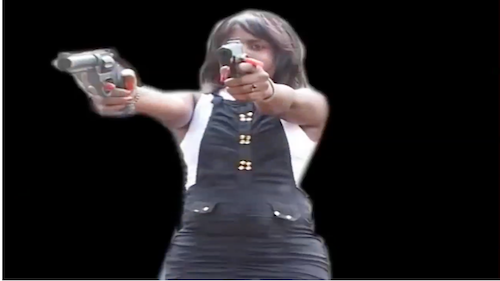A Ugandan filmmaker has discovered a new way to combine storytelling and movies

On Saturday, SIFF presented the West Coast premiere of Bad Black, an action movie from the Ugandan micro-movie studio of Wakaliwood. An American producer named Alan Hofmanis was in attendance to present the film and lead a Skype Q&A with director Nabwana I.G.G.
From a storytelling perspective, Wakaliwood films are unique in all the world. Hofmanis explained the history stretches back some three decades, when VHS tapes of American action films started circulating around the poorest parts of Uganda. There were no subtitles, and many in the slums of Uganda are illiterate, so instead a person would narrate the film for audiences, explaining the dialogue and action as it unfolded on the screen.
The narrators began to get artful with their commentary, making up storylines (Hofmanis said one retelling of Air Force One includes the backstory that the leader of the terrorist organization slept with the president’s wife and gave the First Lady an STD) and adding jokes and color commentary. When Wakaliwood started making movies, the narrators became more like the hype men at a hip-hop show, using hyperbolic color commentary to talk up the action on screen and to emphasize the heroism of the protagonists and the villainy of the antagonists.
Bad Black opens with a character named Swaz (the narrator shouts, “The Ugandan Schwarzenegger! Swaaaaaaaaaz!” much of the time that he’s onscreen) who gets into a gun fight with some troops invading the hospital where his pregnant wife is giving birth. The action unfolds all around the slums of Wakaliga, where Nabwana I.G.G. was born and raised. His friends and neighbors all participate in the film. Nabwana uses practical and (very low-fi) CGI effects to enhance the action.
For American audiences, the most fascinating aspect of Bad Black might be how much American pop culture — particularly 1980s American action films — have permeated the film. You’ll find references to the Karate Kid, Commando, Rambo, Wesley Snipes, The Expendables, and many more films and actors in the 80 or so minutes of Bad Black, most of them inserted by the narrator. And for Seattle audiences, there’s a special treat — Nabwana included a couple of Seattle-centric introductions shot specifically for SIFF.
I’m still wrestling with the questions of colonialism and appropriation in the presentation of Wakaliwood films. A white American producer — albeit one who moved to Uganda to help Nabwana bring his dreams to wider audiences — presenting a Ugandan film for the enjoyment of a mostly white Seattle crowd for the sake of laughs was a bit unsettling.
But is that really any more unsettling than the background child actors in Bad Black wearing our cast-off Spongebob and Rugrats t-shirts? Isn’t the fact that Wakaliwood is finally telling its own story on its own terms important? Isn’t it useful that American audiences are seeing the slums of Wakaliga, with its open sewage and its poverty and its lively day-to-day business? There is no such thing as an unalloyed good or bad here. It’s up to you to run the totals on your own moral balance sheet.
I don’t want to give away any of the best punchlines or story beats of the film. The best part of Bad Black comes in the surprise of it — suffice it to say there are some plot twists straight out of Dickens and some meta-punchlines worthy of Mystery Science Theater 3000. It’s a giddy delight — Nabwana and his friends are high on the very act of filmmaking, and that excitement absolutely transfers to the audience.
But ultimately, for me, the uniqueness of Bad Black all comes back to the narrator. That extra layer of storytelling plays into the wildness of the cinema and makes the whole movie, with all its fake blood and ramped-up conflict, even more enjoyable. It reminds you that the experience of going to a movie is just that — an experience, and one to be enjoyed as thoroughly as possible.
Bad Black plays again tonight at the Egyptian and on Thursday, May 25th, at Majestic Bay.